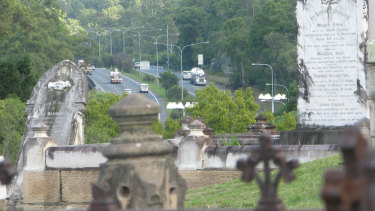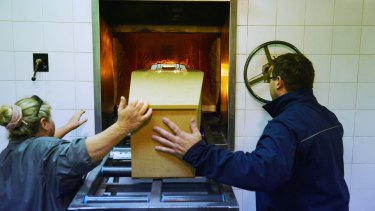https://roseobrienwriter.blog/2019/12/19/cemetery-birds/
By Lydia Lynch
Have you thought about what you want done with your body when you die?
Would you have your ashes turned into jewellery for a loved one to wear? Or you may opt to be buried in a biodegradable coffin with no physical identification of your grave, just a GPS tracking signal.
Space, money and religion are all contributing to a shift in how people are being laid to rest, with almost three-quarters of Queenslanders who died last year being cremated.

The graves of Toowong Cemetery look over the Western Motorway.
The Attorney-General's department recently released its annual body disposal data, which is broken down into burials, cremations and "other".
The data revealed just 23 per cent of people opted for a traditional burial last year.
The "other" category makes up about 5 per cent of all disposals, up from 1 per cent in 2014, and includes missing persons who are presumed dead, those taken interstate to be buried and people who have chosen to donate their bodies to science.
Most Queensland universities run a body donation program where specimens are used in anatomy classes to teach the next generation of health professionals.
Griffith University anatomy facilitator manager Bevan Butcher said the university capped its donations at 45 bodies each year and sometimes had to turn away donors.
https://infogram.com/body-disposals-1hxr4z1y85ey2yo
"If we receive the quota for the year, we close the program. In the last few years we have closed the program in November," he said.
Once a donor has died and their family has given consent, the body is taken to the university by a funeral service.
Once there, technical staff spend two to three hours embalming the body.
"That will chemically preserve the body to protect against mould and bacteria," Mr Butcher said.
"After they are embalmed, we will then store the body in a large cold room for three months to make sure the chemical preservative has taken full effect."
Mr Butcher said people can decide whether to donate their bodies for three years - after which they are cremated and their ashes are returned to the family - or donate indefinitely.
Some donors can be used for anatomy teaching for decades.

Almost three-quarters of Queenslanders who died last year were cremated.CREDIT:NICK MOIR
"Older institutions, they would have pathology pots that go back to 1950s and 1960s," Mr Butcher said.
Only a sliver of Queenslanders donate their bodies to science each year, with the majority of people now choosing to be cremated.
Compassionate Funerals director Karen Blue said as organised religions, traditionally opposed to cremation, have begun to accept it, the need for a "proper Christian burial" has also begun to decline.
"There was a time when families would come in and we would ask if they wanted an Anglican service or a Catholic service," she said.
"Those days are gone and we now live in a very personalised society. Lots of people want different things these days, they want to have choice."
Ms Blue said she thought the trend away from burial and towards cremation was because the latter gave families more options.
"Some want to scatter, some want to wear cremation jewellery, some want cremated remains buried," she said.
"Even just this year I have met with quite a few people who are choosing to have their parents cremated and then taking their ashes back to Ireland, Wales and other parts of the UK, because that is where they originally came from."
Ms Blue, who is also on Queensland's Funeral Director Association council, said cost was also a "significant factor".
"[In Brisbane] you are looking at $5000 to buy a burial plot and that is just the land whereas you are looking at less than $1000 for a chapel and cremation ceremony," she said.
Ms Blue said in Sydney, where land is at a premium, you could pay $15,000-$20,000 for a burial plot.

The cost of burial plots has contributed to a rise in cremations. CREDIT:LOUIE DOUVIS
Brisbane City Council manages 12 cemeteries, of which nine are historic and generally closed for new burials.
Mount Gravatt, Pinnaroo and Hemmant were council’s three operating cemeteries, a spokeswoman said.
"Council has no concerns about the future capacity of cemetery plots with about 40 years of supply identified in existing cemeteries and new land being purchased for future burial plots," she said.
"There are approximately 16,000 graves remaining in council-operated cemeteries that are estimated to provide about 30 years’ worth of burial space.
The spokeswoman said about 4700 potential new plots had been found at council’s historic cemeteries for "further investigation", including areas that were previously difficult to excavate by manual labour but where machinery can now be used.
"This could provide almost a decade’s supply of new plots," she said.









